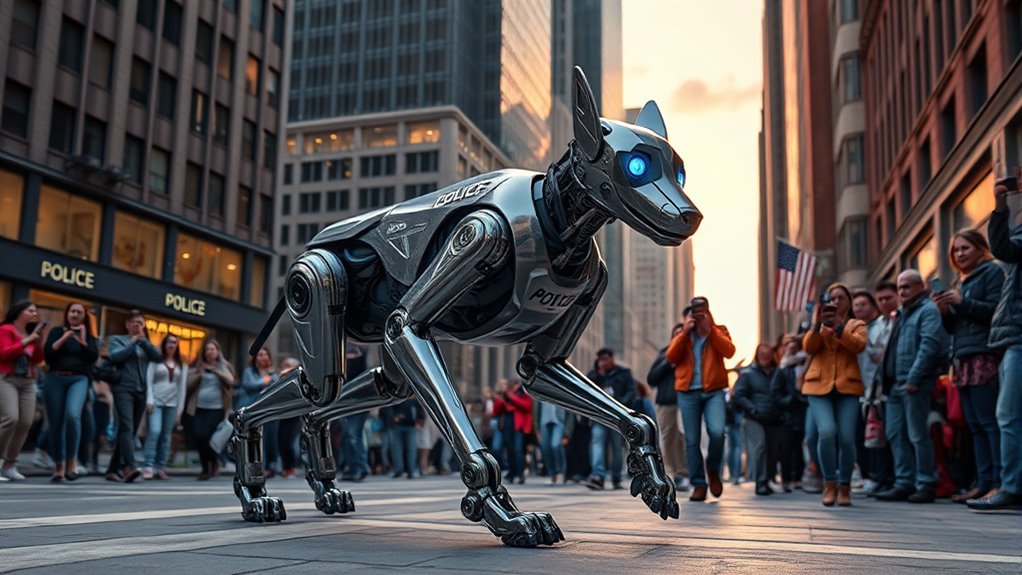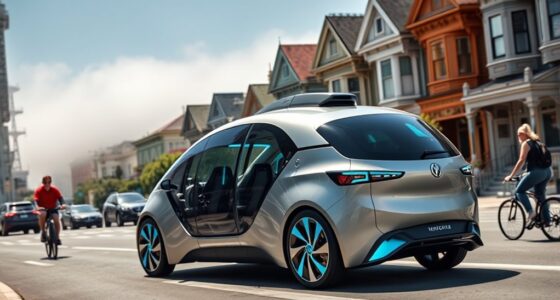The deployment of robot police dogs in New York sparks a debate about safety and ethics. These robots assist law enforcement with patrols, crowd control, and suspect apprehension, but they raise concerns about privacy, constant surveillance, and potential malfunctions. Experts worry about cybersecurity threats, system failures, and misuse of data. If you want to understand how these concerns may impact your rights and safety, keep exploring the details behind this technology’s deployment.
Key Takeaways
- Deployment aims to enhance urban policing efficiency but raises concerns over privacy due to surveillance capabilities.
- The robots’ camera and audio features threaten civil liberties and could lead to excessive monitoring of public spaces.
- Technological reliability issues, including hacking risks and system malfunctions, pose safety concerns during critical incidents.
- Privacy advocates worry about data misuse and the lack of transparency in how surveillance data is collected and stored.
- Ethical debates focus on balancing law enforcement benefits with potential civil rights infringements and the need for proper oversight.

Have you noticed the latest addition to New York’s law enforcement arsenal? Robot police dogs have been deployed, and they’re already stirring up a mix of excitement and concern. These machines are designed to assist officers in patrols, crowd control, and even suspect apprehension. While their arrival promises increased efficiency and safety, it also raises significant questions about privacy concerns and technological reliability. As you consider these developments, it’s important to understand how these factors could impact everyday life in the city.
Robot police dogs in New York raise questions about safety, privacy, and technological reliability.
First, privacy concerns are at the forefront of many residents’ minds. These robot dogs often come equipped with cameras, sensors, and sometimes audio recording capabilities. This means they can monitor public spaces continuously, capturing footage of individuals without their explicit consent. For many, this feels like an intrusion into personal privacy, especially in a city that values its civil liberties. The deployment of such technology could lead to a surveillance culture, where citizens feel constantly watched, potentially chilling free expression and movement. Law enforcement agencies argue that these tools are necessary for safety and crime prevention, but the balance between security and privacy isn’t always clear-cut. You might wonder whether there are sufficient safeguards to prevent misuse or unwarranted surveillance, especially given that these systems could collect data over long periods. Additionally, concerns about the technological reliability of these systems are growing among residents and officials alike. You might wonder whether there are sufficient safeguards to prevent misuse or unwarranted surveillance, especially given that these systems could collect data over long periods. Moreover, ongoing technology advancements could influence how these systems evolve and their effectiveness over time. It’s also important to consider how public perception might affect the acceptance and integration of such technology in community policing efforts. Ensuring transparency about data collection and usage can help build trust and mitigate these concerns.
Alongside privacy issues, the technological reliability of these robot police dogs is a *key* concern. No matter how advanced, technology isn’t infallible. These machines depend on complex algorithms, sensors, and communication systems that can malfunction or be hacked. A glitch or failure during a critical moment could jeopardize safety rather than enhance it. For example, a robot dog might misinterpret a situation, escalate tensions, or even harm innocent bystanders if its sensors give false readings. *Furthermore*, cybersecurity threats pose a real risk. Hackers could potentially gain control of these devices, turning them against the very communities they’re meant to protect. Such vulnerabilities threaten to undermine public confidence and could lead to dangerous situations if not properly managed. Cybersecurity vulnerabilities are a growing concern as malicious actors seek to exploit these systems. Recognizing the importance of system resilience and ongoing maintenance is essential to ensure these devices operate safely and effectively.
While the promise of robotic assistance is clear, it’s essential to scrutinize how reliable and secure these systems truly are. As you watch these robot police dogs patrol your streets, consider whether the benefits outweigh the risks. Will technological reliability hold up in unpredictable real-world scenarios? And how will privacy concerns be addressed to *guarantee* citizens’ rights aren’t compromised? These questions are *crucial* as New York navigates this new era of law enforcement technology. The deployment of robot police dogs might transform policing, but it also demands careful oversight to prevent unintended consequences that could affect everyone’s safety and privacy.
Frequently Asked Questions
What Are the Long-Term Cost Implications of Robot Police Dogs?
When considering the long-term cost implications of robot police dogs, you need to account for automation costs and ongoing maintenance expenses. Automation costs might be high upfront but could reduce personnel costs over time. However, maintenance expenses, including repairs and software updates, can add up quickly. You should evaluate whether the benefits of automation outweigh these ongoing costs to determine if deploying such technology is financially sustainable in the long run.
How Do Robot Police Dogs Detect Threats or Suspects?
You might wonder how robot police dogs detect threats or suspects. They use advanced sensors and robot scenting technology to identify odors associated with humans or illegal substances. These robots analyze the scent patterns for threat detection, allowing them to find suspects even in complex environments. By combining scenting capabilities with real-time data processing, they can efficiently support law enforcement in maintaining safety and quickly responding to threats.
Are There Any International Laws Regulating Robotic Law Enforcement?
You might wonder if international laws regulate robotic law enforcement. Currently, there’s no comprehensive global legal framework specifically for these technologies. International protocols encourage ethical use and respect for human rights, but laws vary widely across countries. As you consider deploying or encountering robotic police, remember that legal standards are evolving, and it’s essential to stay informed about regional regulations and ongoing international discussions to guarantee ethical and lawful use.
How Do Robot Police Dogs Impact Community Trust and Relations?
You might find that robot police dogs affect community trust and relations by shaping public perception and how you engage with law enforcement. If the community sees these robots as helpful and transparent, it boosts trust and encourages positive interactions. However, if people view them as intrusive or threatening, it could harm community engagement. Ultimately, clear communication and responsible use are key to fostering positive relationships and maintaining public confidence.
What Are the Potential Technical Failures of Robot Police Dogs?
You should consider that robot police dogs might experience hardware malfunctions like sensor failures or motor issues, which could impair their movement or decision-making. Software glitches are also a concern, potentially causing incorrect responses or loss of control. These failures could lead to safety risks for officers and civilians, making it vital to guarantee rigorous testing and maintenance. Staying aware of these issues helps you better understand the technology’s limitations and potential vulnerabilities.
Conclusion
As you consider the future of these robot police dogs, remember they can be both helpful and problematic. Imagine a situation where a robot dog detects a threat but mishandles the situation, raising safety concerns. While they can assist in crime prevention, ethical dilemmas about privacy and control remain. It’s up to society to decide how much we trust these machines, ensuring they serve us without compromising our safety or values.









